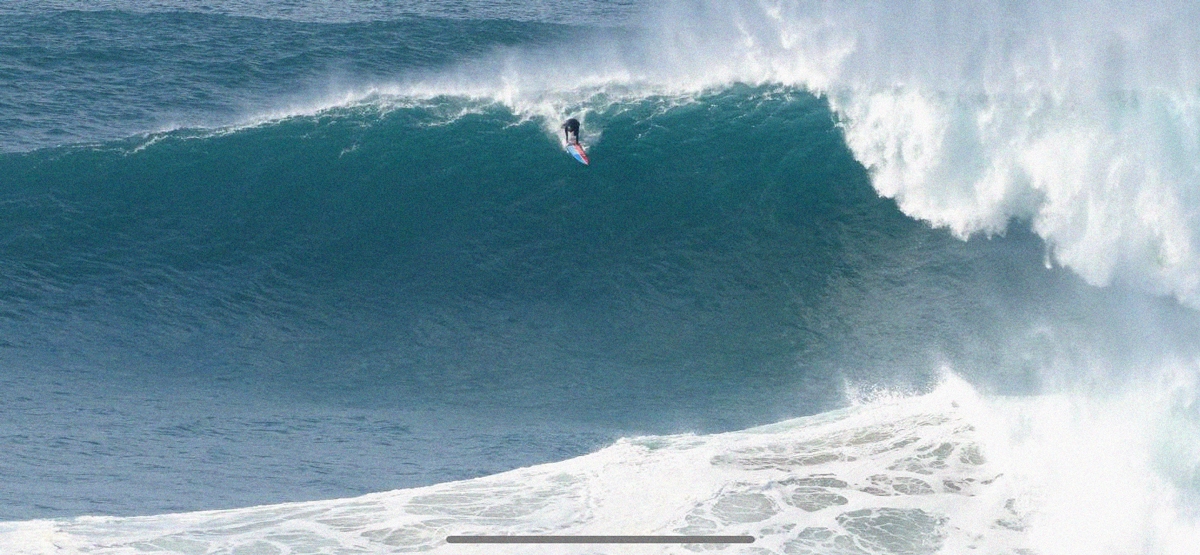South Korea and big wave surfing are rarely mentioned in the same sentence, let alone the same conversation. The country has flown well under the radar of surfers since forever, until recently, when an artificial wave pool was opened in the heart of the capital city, Seoul.
Surrounded by three different coastlines, South Korea is actually home to a bustling surfing community that is growing at an alarming rate. There are waves on offer all year round, with typhoons and wind swells providing several different setups.
Juni Cho was introduced to surfing at the ripe old age of 19, where he attended an event during his first year of college that traced the origins of snowboarding. Infatuated by the sensation of riding waves, he began to work in a surf shop and learn how to surf seriously.
“At first, it was just curiosity, but I quickly fell in love with the freedom and the deep connection with nature. I’ve been surfing ever since.”
Juni went on to represent the Korean National Surf Team for five years. However, becoming a surfer in South Korea isn’t as straightforward as it is for most. South Korean males are required to complete at least 18 months of military service. If they refuse, they are imprisoned, meaning Juni’s surfing opportunities were drastically diminished.




“Once I entered the military, I was hardly allowed to surf, and that was really difficult. I was stationed on Yeonpyeong Island, just 3km from North Korea.
“I managed to surf maybe twice, looking out over the North. But that area was full of landmines and used for live-fire training, so realistically, it was too dangerous.
“At first, I felt incredibly trapped and frustrated. But that frustration became imagination, which would eventually become a dream.”
That dream was to surf big waves. Juni completed his obligatory military service and returned to surfing, but after enduring a deep, personal crisis, he was driven into a dark place mentally, where he contemplated suicide.
“Everything in my life felt like it collapsed. I found myself standing on the balcony of a hotel, eight stories up, with dark thoughts creeping in.
“Then I remembered something from a documentary: the waves at Nazaré are as tall as an eight-story building.
“At that moment, I thought, ‘I hadn’t surfed that wave yet. So, it’s too early to go.’
“That spark — that one strange, poetic moment — made me want to live again. That’s where my big wave dream began.”
Juni’s journey towards the cliffs of Nazaré began with an intense training regime where he would attempt to prepare himself for the monstrous waves that awaited him on the other side of the world.

“Training for big waves in Korea feels like preparing for Everest on a stairwell. I focused on breath holds, physical training, bodysurfing, and especially mental preparation. I practiced surrendering to the ocean, letting it toss me around.
“More than muscle, it’s about your mindset — learning to stay calm when everything turns upside down.”
The obsession to surf Nazaré intensified for Juni the closer he came to leaving for Portugal. He studied the ocean and increased his physical preparation until he found himself standing on those eight-story-tall cliffs.
“I went out to the cliffs every day to study the ocean. I talked with locals, watched the line-up, and tried to absorb everything I could — not just how to surf it, but how to respect it.”
After watching and waiting, Juni finally entered the Atlantic Ocean. Every bit of training and mental preparation was finally about to be put to the test. He had a desire to tackle the biggest waves he possibly could. No jet ski, no safety team — just him, his board, and the ocean.
“I started with two-metre waves, then I gradually built up the courage until I got thrown from a 12-metre wave. That’s when it hit me — this is big wave surfing.
“And when I got wiped out by a 15-20-metre wave, it was pure pain. It wasn’t surfing anymore; it was survival.
“But every wave I made it down, it felt like I had everything I ever needed in that moment.”
From the edge of a balcony to the peaks of Nazaré, Juni had turned his life around in spectacular fashion and wanted to share the experience with as many people as he could. Although he couldn’t physically bring the waves of Nazaré to Korea, Juni wanted to bring the emotions and the healing that it had given him to his people.




“That’s how Nazaré Surfhouse was born. It’s not just a place to learn how to surf — it’s a place to recover, to reconnect, and to rediscover who you are.
“I wanted to create a space where anyone could come and find their Nazaré.”
Juni plans to return to Nazaré for what would be a third attempt, but this time with a complete safety plan in place. He not only wants to surf bigger and better waves, but he also wants to inspire others who are restricted by fear.
“Right now, the wave at Nazaré is the biggest fear in my life, and I want to face it. My dream is to become someone who gives hope and courage to others. Someone who helps people say ‘yes’ when they’re afraid.
“I want to live a life where I spread positive language, not just in surfing, but in everything I do.”




